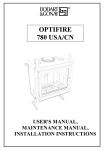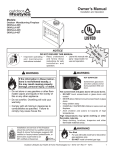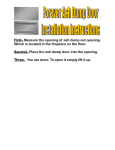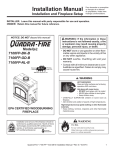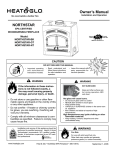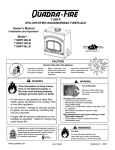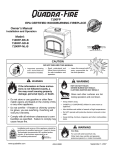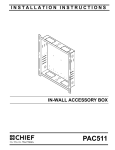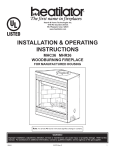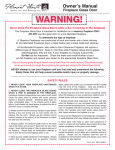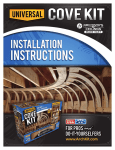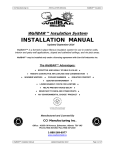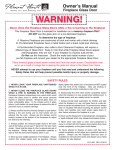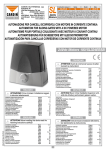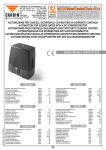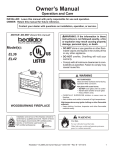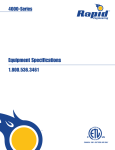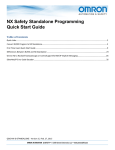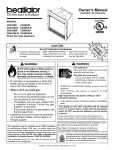Download Installation Manual - Hearth & Home Technologies
Transcript
Installation Manual Installation and Fireplace Setup INSTALLER: Leave this manual with party responsible for use and operation. OWNER: Retain this manual for future reference. NOTICE: DO NOT discard this manual! Model(s): EL36 EL42 WARNING: If the information in these instructions is not followed exactly, a fire or explosion may result causing property damage, personal injury, or death. • DO NOT store or use gasoline or other flammable vapors and liquids in the vicinity of this or any other appliance. • DO NOT overfire. Overfiring will void your warranty. • Comply with all minimum clearances to combustibles as specified. Failure to comply may cause house fire. WARNING HOT SURFACES! Glass and other surfaces are hot during operation AND cool down. Hot glass will cause burns. • DO NOT touch glass until it is cooled • NEVER allow children to touch glass • Keep children away • CAREFULLY SUPERVISE children in same room as fireplace. • Alert children and adults to hazards of high temperatures. WOODBURNING FIREPLACE Installation and service of this fireplace should be performed by qualified personnel. Hearth & Home Technologies recommends NFI certified professionals, or technicians supervised by an NFI certified professional. High temperatures may ignite clothing or other flammable materials. • Keep clothing, furniture, draperies and other flammable materials away. WARNING Fire Risk. For use with solid wood fuel only. Other fuels may overfire and generate poisonous gases (i.e. carbon monoxide). Heatilator • EL36/EL42 • 4044-188 Installation Manual • Rev G • 01/28/15 1 Safety Alert Key: DANGER! Indicates a hazardous situation which, if not avoided will result in death or serious injury. WARNING! Indicates a hazardous situation which, if not avoided could result in death or serious injury. CAUTION! Indicates a hazardous situation which, if not avoided, could result in minor or moderate injury. NOTICE: Indicates practices which may cause damage to the fireplace or to property. • • • • Table of Contents 1 Product Specific & Important Safety Information A. Fireplace Certification B. Non-Combustible Materials C.Combustible Materials 2 Getting Started A. Typical Fireplace System B. Design and Installation Considerations 1. Selecting Fireplace Locations 2. Locating Fireplace & Chimney C.Tools and Supplies Needed D.Inspect Fireplace and Components E. Fireplace System Requirements 3 Framing and Clearances A. Fireplace Dimensions B. Clearances Minimum Clearances to Combustibles C.Construct the Chase D.Frame the Fireplace E. Secure and Level the Fireplace F. Protective Metal Hearth Strips G.Outside Air Kit (optional) 4 Chimney and Termination Requirements A. Chimney Requirements B. Offsets/Returns C.Termination Requirements 5 Chimney Installation A. Typical Chimney System B. Assemble Chimney Sections C.Install Chimney Air Kit D.Secure Offset/Return E. Install Ceiling Firestops F. Install Attic Insulation Shield G.Roof Penetration H.Install Chase/Chase Top I. Termination Cap Requirements J. Install Termination Cap 2 4 4 4 5 6 6 7 8 8 8 9 10 10 11 12 12 13 14 15 16 17 6Shrouds A. Radiation Shield B. Field Constructed Shrouds 1. Open Top Shroud 2. Mailbox Style Shroud 3. Roofed Style Shroud 7Finishing A. Finishing Material B. Hearth Extension, Building and Finishing 1. Hearth Extension 4” or more below Fireplace Opening 2. Raised Hearth Extension Less Than 4” Below Fireplace Opening 3. Fireplace Opening and Hearth Extension Flush with Floor C.Non-Combustible Sealant Material D.Mantel and Wall Projections E. Sidewalls/Surrounds 8 Fireplace Setup A. Gas Log/Lighter Provision B. Wood Burning Inserts 9 Reference Materials A. Chimney Components B. Optional Components 18 19 19 20 20 21 22 22 23 23 Heatilator • EL36/EL42 • 4044-188 Installation Manual • Rev G • 01/28/15 25 25 25 26 26 27 28 29 29 30 30 31 32 33 33 34 38 ATTENTION INSTALLER: Follow this Standard Work Checklist This standard work checklist is to be used by the installer in conjuction with, not instead of, the instructions contained in this installation manual. Customer: Lot/Address Model (circle one): EL36 EL42 Date Installed: Location of Fireplace: Installer: Dealer/Distributor Phone # Serial #: WARNING! Risk of Fire or Explosion! Failure to install fireplace acording to these instructions can lead to a fire or explosion. Fireplace Install Verified that the chase is insulated and sealed. (Pg. 11) Verified clearances to combustibles. (Pg. 10) Fireplace is leveled and secured. (Pg. 12) Protective hearth strips installed per manual requirements. (Pg. 13) Hearth extension size/height decided. (Pg. 28) Outside air kit installed. (Pg 14) YES IF NO, WHY? Chimney Section 4 & 5 (Pg. 15) Chimney configuration complies with diagrams. Chimney installed, locked and secured in place with proper clearance. Chimney air kit installed. Firestops installed. Attic insulation shield installed. Roof flashing installed. Termination installed. Shrouds Section 6 (Pg. 25) Shroud is installed properly per instructions. Finishing Fi i hi S Section ti 7 (P (Pg. 27) Combustible materials not installed in non-combustible areas. Verified all clearances meet installation manual requirements. Mantels and wall projections comply with installation manual requirements. Hearth extension installed per manual requirements. Fireplace Setup Section 8 (Pg. 34) All packaging and protective materials removed. Refractory installed correctly. Grate is properly installed. Firescreen properly installed. Optional doors properly installed. Manual bag and all of its contents are removed from the fireplace and given to the party responsible for use and operation. Hearth & Home Technologies recommends the following: • Photographing the installation and copying this checklist for your file. • That this checklist remain visible at all times on the fireplace until the installation is complete. Comments: Further description of the issues, who is responsible (Installer/Builder/Other Trades, etc.) and corrective action needed: Comments communicated to party responsible __________________________ by ______________________on _________ (Builder/Gen. Contractor) (Installer) (Date) 4044-189 • Rev A • 3-26-13 Heatilator • EL36/EL42 • 4044-188 Installation Manual • Rev G • 01/28/15 3 1 Product Specific & Important Safety Information A.Fireplace Certification This fireplace system has been tested and listed in accordance with UL 127 and ULC-S610 standards by Underwriters Laboratories Inc. for installation and operation in the United States and Canada. This fireplace may be installed in sleeping rooms EXCEPT in manufactured homes. If installed with a gas log set, provisions for the National Fuel Gas Code must be met. This fireplace has been tested and listed for use with the optional components specified in this manual. These optional components may be purchased separately and installed at a later date. An outside air kit, gas insert, gas log set or gas log-lighter should be installed at the time of fireplace installation. Heatilator is a registered trademark of Hearth & Home Technologies. B.Non-Combustible Materials • Materials which will not ignite and burn, composed of any combination of the following: - Steel - Iron - Brick - Tile - Concrete - Slate - Glass - Plasters • Materials reported as passing ASTM E 136, Standard Test Method for Behavior of Metals, in a Vertical Tube Furnace at 750° C C.Combustible Materials • Materials made of or surfaced with any of the following materials: - Wood - Compressed paper - Plant fibers - Plastic - Plywood/OSB - Sheet rock (drywall) • Any material that can ignite and burn; flame proofed or not, plastered or un-plastered Warning! Risk of Fire! Hearth & Home Technologies disclaims any responsibility for, and the warranty and agency listing will be voided by the following actions. DO NOT: • install or operate damaged fireplace • modify fireplace • install other than as instructed by Hearth & Home Technologies • operate the fireplace without fully assembling all components • overfire • install unvented gas log set • install any component not approved by Hearth & Home Technologies • install parts or components not Listed or approved Improper installation, adjustment, alteration, service or maintenance can cause injury or property damage. For assistance or additional information, consult a qualified installer, service agency or your dealer. 4 Heatilator • EL36/EL42 • 4044-188 Installation Manual • Rev G • 01/28/15 2 Getting Started A.Typical Fireplace System Additional lateral support for chimney above roof (or enclosed in chase) if needed Termination cap Storm Collar Non-combustible roof flashing maintains minimum clearance around chimney Chimney penetrates roof preferably without affecting roof rafters Offset & Return (with hanger straps) Support straps on rafter support chimney (not shown) Attic insulation shield must be used here to keep insulation away from chimney if attic is insulated Ceiling firestop on floor of attic Chimney system Framing headed off in ceiling joists Combustible framing/header on top of V-shaped standoffs ))) ))) )))) )))) Mantel and surround ))) ) ))) ) ) )) ))) ))) ) ) Chimney Air Kit Required in Canada. Outlet must be no less than 4 ft. (1.22 m) off ground level. Enclosed space above and around fireplace ))) ) ))))) )))))))))))))))) ))) Decorative facing and trim Hearth extension Outside combustion air Factory-built fireplace Protective metal hearth strip(s) Figure 2.1 Typical Fireplace System Heatilator • EL36/EL42 • 4044-188 Installation Manual • Rev G • 01/28/15 5 B.Design and Installation Considerations Locating the fireplace in a basement should be avoided. Locating near frequently opened doors, central heat outlets or returns, or other locations of considerable air movement can affect the performance. Notice: Check building codes prior to installation. • Installation MUST comply with local, regional, state and national codes and regulations. • Consult insurance carrier, local building inspector, fire officials or authorities having jurisdiction over restrictions, installation inspection and permits. • Before installing, determine the following: - Where the fireplace is to be installed. - The vent system configuration to be used. - Gas supply piping. - Electrical wiring. - Framing and finishing details. Consideration should be given to these factors before deciding on a location. NOTICE: In addition to these framing dimensions, also reference the following section: • Clearances (Section 3). NOTICE: • Illustrations and photos reflect typical installations and are FOR DESIGN PURPOSES ONLY. • Illustrations/diagrams are not drawn to scale. • Actual installation/appearance may vary due to individual design preference. • Hearth & Home Technologies reserves the right to alter its products. Note: A raised hearth extension built flush with the fireplace opening or less than 4 in. (102 mm) below the fireplace opening requires the fireplace be installed on a non-combustible surface. NOTICE: A minimum 1/2 in. air clearance at the back and sides of the fireplace assembly must be maintained. - Whether optional accessories - devices such as a fan, wall switch or remote control - are desired. 1. Selecting Fireplace Locations Chimney sections at any level require a 2 in. minimum air space clearance between the framing and chimney sections. This fireplace may be used as a room divider, installed along a wall, across a corner or used in an exterior chase. See Figure 2.2. G H F A B* A C * 8 in. (203 mm) extra space included for outside air connection. If outside air duct has no bend, this dimension may be reduced as long as minimum clearances are met. I In an exterior chase or projecting into a garage Across a corner Note: 1/2 in. (13 mm) min. air space from fireplace to combustible materials. E H As a room divider Along a wall D A I B 48 in. (1219 mm) minimum 1/2 in. (13 mm) all configurations A H Note: Measurements are FRAMING dimensions only and do not include drywall either in the cavity or on the interior walls. Model EL36 EL42 inches mm inches mm A 42 1067 48 1219 B 50 1270 56 1422 C 67 7/8 1724 73 7/8 1876 D 59 1/2 1511 65 1/2 1664 E 34 864 37 1/4 946 F 14 356 14 356 G 48 1219 52 1/4 1327 H 21 1/2 546 21 1/2 546 Figure 2.2 Fireplace Locations 6 I 12 in. (305 mm) Minimum from FP opening to any perpendicular wall. Heatilator • EL36/EL42 • 4044-188 Installation Manual • Rev G • 01/28/15 2. Locating Fireplace & Chimney Location of the fireplace and chimney will affect performance. • Install within the warm airspace enclosed by the building envelope. This helps to produce more draft, especially during lighting and die-down of the fire. • Installing the fireplace in a basement is not recommended. • Penetrate the highest part of the roof. This minimizes the effects of wind loading. • Locate termination cap away from trees, adjacent structures, uneven roof lines and other obstructions. • Minimize the use of chimney offsets. • Consider the fireplace location relative to floor and ceiling and attic joists. • Take into consideration the termination requirements in Sections 4 and 5. Recommended Location: • Above peak • Install the outside air kit with the intake facing prevailing winds during the heating season. • Ensure adequate outdoor air for all combustion appliances and exhaust equipment. • Ensure furnace and air conditioning return vents are not located in the immediate vicinity of the fireplace. • Avoid installing the fireplace near doors, walkways or small isolated spaces. • Recessed lighting should be a “sealed can” design. • Attic hatches weather stripped or sealed. • Attic mounted duct work and air handler joints and seams taped or sealed. Recommended Location: • Above peak • Inside heated space Marginal Location: • Below peak Marginal Location: • Wind loading possible Location NOT recommended: • Not the highest point of the roof • Wind loading possible Recommended: • Insulated exterior chase in cooler climates Location NOT recommended: • Too close to tree • Below adjacent structure • Lower roof line • Avoid outside wall Windward Leeward Figure 2.3 Recommended Chimney Locations Multi-level Roofs Heatilator • EL36/EL42 • 4044-188 Installation Manual • Rev G • 01/28/15 7 C.Tools and Supplies Needed E. Fireplace System Requirements Before beginning the installation be sure the following tools and building supplies are available: The Heatilator fireplace system requirements consist of the following: Reciprocating saw Framing material Pliers Non-combustible sealant Hammer Gloves Phillips screwdriver Framing square Flat blade screwdriver Electric drill and bits Plumb line Safety glasses Level Tape measure • Fireplace - Refractory (included with fireplace) - Firescreen (included with fireplace) - Grate (included with fireplace) - Hearth Extension (required, sold separately) • Outside Air System (optional) - Air Inlet Hood - Flex • Chimney System - Attic Insulation Shield (included with fireplace) - Chimney air kit (required in Canada, sold separately) - Chimney termination cap (required, sold separately) • Non-combustible finish material 1/2-3/4 in. length, #6 or #8 self-drilling screws Misc. screws and nails D.Inspect Fireplace and Components Warning! Risk of Fire and/or Explosion! Damaged parts could impair safe operation. Do NOT install damaged, incomplete or substitute components. Keep fireplace dry. • Remove fireplace and components from packaging and inspect for damage. • Vent system components and doors are shipped in separate packages. • Report to your dealer any parts damaged in shipment. • Read all the instructions before starting the installation. Follow these instructions carefully during the installation to ensure maximum safety and benefit. 8 Heatilator • EL36/EL42 • 4044-188 Installation Manual • Rev G • 01/28/15 3 Framing and Clearances A.Fireplace Dimensions C 7-3/8 in. (187 mm) D 21-3/8 in. (543 mm) B 7-1/2 in. (191 mm) Outside Air 21 in. (533 mm) 21 in. (533 mm) 18-3/4 in. (476 mm) Gas Knockout 9-1/4 in. (235 mm) 39-1/2 in. (1003 mm) Gas Knockout 9-1/4 in. (235 mm) 7-1/2 in. (191 mm) 7-1/2 in. (191 mm) A Model # EL36 EL42 14-1/8 in. (359 mm) A B C D in. 36 41 23-3/4 11-7/8 mm 914 1041 603 302 in. 42 47 29-3/4 14-7/8 mm 1067 1194 756 378 7-1/2 in. (191 mm) Figure 3.1 Fireplace Dimensions Heatilator • EL36/EL42 • 4044-188 Installation Manual • Rev G • 01/28/15 9 B.Clearances Minimum Clearances to Combustibles Warning! Risk of Fire! You must comply with all minimum air space clearances to combustibles as specified in Figure 3.2. Do NOT pack required air spaces with insulation or other materials. Framing or finishing material used on the front of, or in front of, the fireplace closer than the minimums listed must be constructed entirely of non-combustible materials (i.e., steel studs, concrete board, etc.). Failure to comply may cause fire. WITHIN ENCLOSURE AREA Fireplace to backwall 1/2 in. (13 mm) Fireplace to sidewall 1/2 in. (13 mm) Top standoffs to header 0 in. (0 mm) Door opening to sidewall 12 in. (305 mm) MANTEL Mantel minimum height 12 in. (305mm) above opening Maximum mantel depth Storm Collar Roof Flashing 12 in. (305 mm) of) (ro Shaded areas represent 2 in. (51 mm) min. air space clearance required around pipe (attic) Attic Insulation Shield (insulation) (ceiling) Offset/Return (secured with hanger straps) 2 in. (51 mm) min. (ceiling) Must have 2 in. (51 mm) minimum clearance to header Ceiling Firestop Note: Chimney air kit is not shown, but is required in Canada. Combustible Object 0 in. to level of standoffs 1/2 in. (13 mm) to back & sides of appliance 48 in. 1219 mm 0 in. to floor Figure 3.2 Clearances to Combustible Materials 10 Heatilator • EL36/EL42 • 4044-188 Installation Manual • Rev G • 01/28/15 C.Construct the Chase A chase is a vertical boxlike structure built to enclose the fireplace and/or its vent system. Vertical chimneys that run on the outside of a building must be installed inside a chase. Round Termination Cap Metal Chase Top Ceiling Firestop In cold climates, Hearth & Home Technologies recommends that the chase be well insulated using batt type insulation between the joists. Construction of the chase may vary with the type of building. These instructions are not substitutes for the requirements of local building codes. Local building codes MUST be checked. Chases should be constructed in the manner of all outside walls of the home to prevent cold air drafting problems. The chase should not break the outside building envelope in any manner. All outer walls need to be insulated. Building codes require false ceiling and ceiling firestops/ attic shields at each floor of the chase or every 10 ft (3048 mm) of clear space to control spread of fire. Walls, ceiling, base plate and cantilever floor at the first level of the chase should be insulated (see Figure 3.3.) Vapor and air infiltration barriers should be installed in the chase as per regional codes for the rest of the home. Additionally, Hearth & Home Technologies recommends that the inside surfaces be drywalled and taped (or the use of an equivalent method) for maximum air tightness. Holes and other openings should be caulked with high temperature caulk or stuffed with unfaced fiberglass insulation. Warning! You must install false ceilings and ceiling firestops at each floor of the chase or every 10 ft (3.05 m) to control spread of fire. Warning! Risk of Fire! Do not seal area between fire stop opening and chimney pipe except where they enter the attic or leave the warm air envelope of the home (use 600° F sealant). • The chase is constructed using framing materials much the same as the walls in your home. A variety of siding materials may be used including brick, stone, veneer brick, or standard siding materials. • In constructing the chase, several factors must be considered: - Maintain a 2 in. (51 mm) air space around the chimney. - The chase top must be constructed of noncombustible material. - In cold climates, a firestop spacer and attic insulation shield should be installed in an insulated false ceiling at the 8 ft. (2438 mm) level above the fireplace assembly. This reduces heat loss through the chase. - In cold climates, the walls of the chase should be insulated to the level of the false ceiling as shown in Figure 3.3. This will help reduce heat loss from the home around the fireplace. False Ceiling Tabs Attic Insulation Shield Ceiling Firestop Insulation False Ceiling Insulation in the outside walls of the chase Insulation False Ceiling Chimney Figure 3.3 Chase Assembly Warning! Risk of Fire! You must maintain a minimum 2 in. (51 mm) air space clearance to insulation and other materials surrounding the chimney system. • Insulation and other materials must be firmly secured to prevent accidental contact with chimney system. • The chase must be properly blocked to prevent blown insulation or other combustibles from entering and making contact with fireplace or chimney. • Failure to prevent contact between insulation or other materials and chimney system may cause overheating and fire. Three examples of chase applications are shown in Figure 3.4. 1. Fireplace and chimney enclosed in an exterior chase. 2. Chimney offset through exterior wall and enclosed in chase. 3. Chase constructed on roof. Note: In cooler climates, all chase walls should be insulated. 1 2 Figure 3.4 Chase Constructions Heatilator • EL36/EL42 • 4044-188 Installation Manual • Rev G • 01/28/15 3 11 D.Frame the Fireplace Notice: Hearth extension design must be determined before installation of fireplace. The finished cavity depth must be no less than 21 3/8 in. (543 mm) from the finished backwall to the outside of front wall framing. Framing must extend straight up all the way to the ceiling. If the fireplace is placed on the floor the maximum height of a finished raised hearth is 7 1/2”. If you want a higher raised hearth the fireplace must be placed on a platform. Caution! Risk of Cuts/Abrasions. Wear protective gloves and safety glasses during installation. Sheet metal edges are sharp. Warning! Risk of Fire. A raised hearth extension built flush with the fireplace opening or less than 4 in. (102 mm) below the fireplace opening requires the fireplace be installed on a non-combustible surface. WARNING! Risk of Fire! Comply with all minimum clearances specified. • A minimum 1/2 in. (13 mm) air clearance must be maintained at the back and sides of the fireplace assembly. • Chimney sections at any level require a 2 in. (51 mm) minimum air space clearance between the framing and chimney section. Warning! Risk of Fire! You must comply with all minimum air space clearances to combustibles. Do NOT pack required air spaces with insulation or other materials. Figure 3.5 shows a typical framing (using 2 x 4 lumber) of the fireplace, assuming combustible materials are used. All required clearances to combustibles around the fireplace must be adhered to. See Figure 3.2. Any framing across the top of the fireplace must be above the level of the top standoffs. (No recess above standoffs.) E. Secure and Level the Fireplace This fireplace may be placed on either a combustible or noncombustible continuous flat surface. Follow the instructions for framing in Section 3. Slide the fireplace into position. Be sure to provide the minimum 1/2 in. air clearance at the sides and back of the fireplace. The fireplace should be positioned so the face of the noncombustible material on the fireplace will be flush with the face of the drywall on the walls. Level the fireplace and shim as necessary. Warning! Risk of Fire! Prevent contact with sagging, loose insulation. • DO NOT install against vapor barriers or exposed insulation. • Secure insulation and vapor barriers. • Provide minimum air space clearances at the sides and back of the fireplace assembly. 2 in. (51 mm) min. air space clearance from chimney. 1/2 in. (13 mm) Fireplace must be set out 1/2 in. (13 mm) in front of the face of the framing material. Header MUST NOT be notched! C D A B D = extra space needed for outside air connection. If outside air duct has no bend, this dimension may be reduced as long as minimum clearances are met. Model EL36 EL42 in. mm in. mm A B* C** D 42 1067 48 1219 21 1/ 2 546 21 1/ 2 546 39 3/ 4 1010 39 3/ 4 1010 8 203 8 203 * If interior of chase will be drywalled, add the thickness to this measurement. ** Adjust header height for a raised floor under fireplace. Figure 3.5 Framing the Fireplace 12 Heatilator • EL36/EL42 • 4044-188 Installation Manual • Rev G • 01/28/15 F. Protective Metal Hearth Strips Warning! Risk of Fire! Protective metal hearth strips MUST be installed on combustible surfaces. DO NOT cover metal strips with combustible materials. Sparks or embers may ignite flooring. WARNING! Risk of fire! High temperatures, sparks, embers or other burning material falling from the fireplace may ignite flooring or concealed combustible surfaces. • Protective metal hearth strips MUST be installed. • Hearth extensions MUST be installed exactly as specified. • Locate the two protective metal hearth strips measuring approximately 26 in. x 4 in. (660 mm x 102 mm) included with this fireplace. • Slide each metal strip 2 in. (51 mm) under front edge of fireplace. • Overlap strips in the middle of fireplace opening by 1 in. (25 mm) minimum. • Metal strips must extend beyond the front and sides of the fireplace opening by at least 2 in. (51 mm), Figure 3.6). • Protect the front of a platform elevated above the hearth extension with metal strips (not included with fireplace) per Figure 3.6. See Section 7 for hearth extension instructions. Protective metal strips are placed 2 in. (51 mm) under the front of the fireplace and must extend beyond the front and sides of fireplace opening by 2 in. (51 mm) Figure 3.6 Position the Protective Metal Hearth Strips Top piece must overlap bottom piece Raised Platform 2 in. (51 mm) 1 in. (25 mm) min. overlap Floor 2 in. (51 mm) Figure 3.7 Protect the Front of an Elevated Platform Heatilator • EL36/EL42 • 4044-188 Installation Manual • Rev G • 01/28/15 13 G.Outside Air Kit (optional) Caution! Risk of Cuts/Abrasions. Wear protective gloves and safety glasses during installation. Sheet metal edges are sharp. If you install an outside air kit, Hearth & Home Technologies recommends you utilize the shortest duct run to optimize the performance of the outside air kit. The outside air inlet hood should be positioned in a manner that will not allow snow, leaves, etc. to block the inlet. In some installations the air duct may need to be run vertically. In such an installation, a 3 ft (914 mm) height difference must be maintained from the top of the uppermost chimney section to the outside air inlet hood. Refer to Figures 3.8 and 3.9 when placing the outside air inlet hood. The outside air kit is installed on the left hand side of the fireplace. )))) )))))))))) ) )))))))))))))))))))))))) )))))))))))))))))))))))))) • Cut a 4-1/2 in. (114 mm) hole in outside wall to accommodate air piping. • Use 4 in. (102 mm) flex (not supplied) to directly connect outside air to fireplace intake. Insulate the pipe to prevent frost condensation. • Seal between the wall and the pipe with silicone to prevent moisture penetration and air leaks. • Seal between the outside air inlet hood and the house with silicone to prevent air infiltration. 3 ft min. from top of uppermost chimney section to air inlet. )) ) )) ) ) ) )))) )))))))))))))))) ) ) )) Caution! Risk of Fire or Asphyxiation! Do not draw outside combustion air from wall, floor or ceiling cavity, or enclosed spaces such as an attic or garage. • Do not place outside air inlet hood close to exhaust vents or chimneys. Fumes or odor could be drawn into the room through the fireplace. • Locate outside air inlet hood to prevent blockage from leaves, snow/ice, or other debris. Blockages could cause combustion air starvation. NO Outlet blocked by snow, leaves, etc. Note: Chimney air kit is not shown, but is required in Canada. Figure 3.8 Outside Air Inlet Locations NO Garage or combustible liquids storage NO Attic space NO Outlet placed higher than 3 ft below the termination cap YES Clear area outside house or in ventilated crawl space Factory-built fireplace • Use UL181 Class 0 or Class 1 rigid or flexible ducting. • Install with short run or mainly straight duct, except small dip for cold air trap which will help prevent flow of cold air. • Secure flex duct with screws or wire ties. Figure 3.9 Outside Air Installation 14 Heatilator • EL36/EL42 • 4044-188 Installation Manual • Rev G • 01/28/15 4 Chimney and Termination Requirements A.Chimney Requirements Vertical distances are measured from the base of the fireplace as shown in Figure 4.1. Table 4.1 Chimney Requirements • Minimum overall straight height 13 (3.96 m) 14.5 ft (4.42 m) • Maximum height 90 ft (27.43 m) • Maximum chimney length between an offset and return 20 ft (6.1 m) • Maximum distance between chimney stabilizers 35 ft (10.67 m) • Double offset/return minimum height 20 ft (6.1 m) • Minimum height with offset/return • Maximum unsupported chimney length between the offset and return • Maximum unsupported chimney height above the fireplace • Maximum unsupported chimney above roof 6 ft (1.83 m) 35 ft (10.67 m) 6 ft (1.83 m) NOTICE: A maximum of two pairs of offsets and returns may be used. NOTICE: You must provide support for the pipe during construction and check to be sure inadvertent loading has not dislodged the chimney section from the fireplace or at any chimney joint. Table 4.2 Chimney Component Dimensions HEIGHT OF CHIMNEY COMPONENTS in. mm 4-3/4 121 SL315 13-3/8 340 SL330 15-1/2 394 SL306 4-3/4 121 SL312 10-3/4 273 SL318 16-3/4 425 SL324 22-3/4 578 SL336 34-3/4 883 SL348 46-3/4 1187 Chimney Stabilizer SL3 Offsets/Returns Chimney Sections* * Dimensions reflect effective height. Warning! Risk of Fire! You must maintain 2 in. (51 mm) air space clearance to insulation and other combustible materials around the chimney system. Failure to do so may cause overheating and fire. 6 ft (1.83 m) max. unsupported chimney above roof 20 ft (6.10 m) max. pipe between an offset & return Ceiling Firestop 39 1/2 in. (1003 mm) Effective Height 35 ft (10.67 m) max. straight unsupported chimney height 14.5 ft (4.42 m) min. height/single offset-return 20 ft. (6.1 m) min. height/double offset-return 90 ft (27.43 m) max. height Figure 4.1 Chimney Requirements Heatilator • EL36/EL42 • 4044-188 Installation Manual • Rev G • 01/28/15 15 B.Offsets/Returns • Use an offset/return to bypass overhead obstructions. • An offset and return can be used as a single entity or separated by chimney section(s). Warning! Risk of Fire! Do not use offset/returns greater than 30°. Chimney draft will be restricted and could cause overheating and fire. Secure offsets with screws ( not to exceed 1/2” / 13 mm in length) Secure returns with strapping. Straight chimney sections may be secured with screws. Keep chimney sections from separating or twisting. • Measure the shift needed to avoid the overhead obstruction. Refer to dimension A in Figure 4.2. • Find the appropriate A dimension listed in Table 4.3. The B dimension coinciding with the A dimension measurement in Table 4.3 represents the required vertical clearance needed to complete the offset/return. • Read across the chart to find the number of chimney sections/model numbers needed between the offset and return. Example: A Your “A” dimension from Figure 4.2 is 14-1/2 in. (368 mm). Using Table 4.3 the dimension closest to, but not less than 14-1/2 in. (368 mm) is 14-1/2 in. (368 mm) using a 30° offs







































